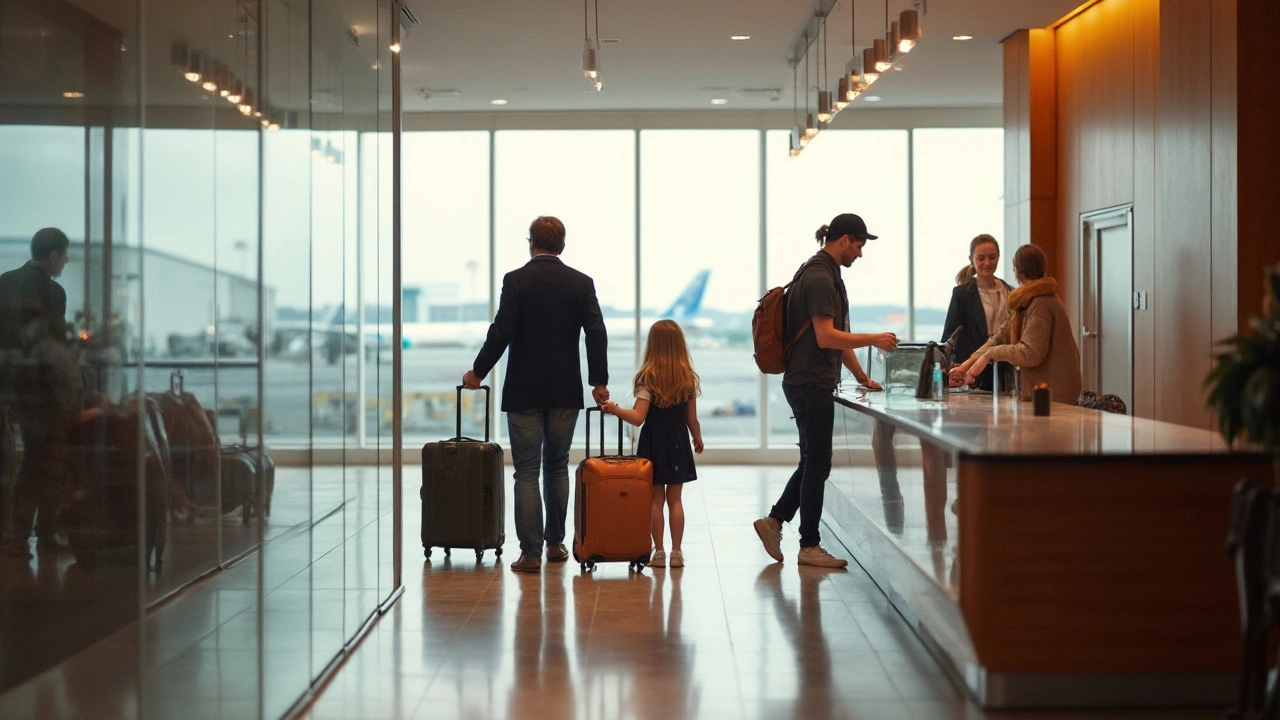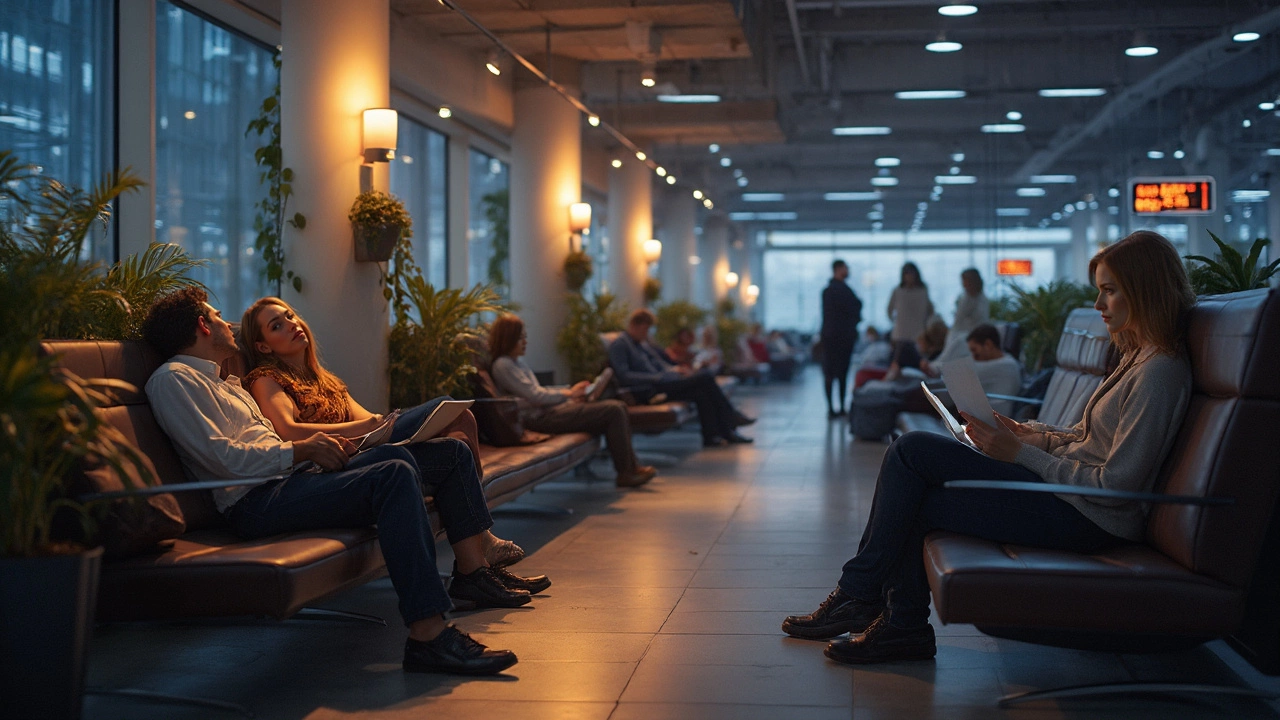Sleeping at the airport isn’t just for backpackers and budget travelers anymore. These days, tons of airports have recognized that people actually want somewhere safe and semi-private to crash—sometimes for just a nap, sometimes for a whole night. But here’s the thing: there’s no one-size-fits-all setup, and the options vary a ton depending on where you are.
You might be picturing some kind of magical room with a bed and a door that locks. Well, yes and no. Some airports—think Singapore Changi or Doha Hamad—go all out with nap pods, tiny micro-hotels, or full-blown mini hotel rooms right inside security. Other places barely have a bench without armrests. Knowing what’s available can mean the difference between an awkward night on the floor and waking up actually rested for your next flight.
- What Are Airport Sleeping Rooms?
- Where to Find Sleeping Rooms Inside Airports
- Airport Hotels vs. In-Terminal Options
- Tips for a Good Sleep at the Airport
What Are Airport Sleeping Rooms?
Airport sleeping rooms are special spots designed for travelers to get some proper rest without leaving the terminal. They’re nothing like the old days of curling up on hard chairs or fighting for a quiet corner. These rooms come in a few shapes and sizes, from single-person sleep pods to small but private hotel rooms with a bed and sometimes a shower. The whole idea is to make overnight stays and long layovers way less miserable and a lot more comfortable.
Here’s what you’ll typically find in an airport sleeping room:
- Basic pods or “capsules”: These are small, private units, often just big enough to lie down. Think of them as a cross between a lounge chair and a tiny personal cabin. You’ll find them in airports like Tokyo Haneda and Helsinki.
- Mini hotel rooms: Some airports, like London Heathrow and Amsterdam Schiphol, have actual mini hotel rooms inside the terminal. They’re private, sound-insulated, and usually come with a small bed, a desk, and sometimes a private bathroom.
- Lounge nap areas: Not quite a full room, but some lounges have dedicated nap spaces or recliners. Priority Pass and airline lounges sometimes offer these perks, but not always the privacy of a lockable door.
The cost can vary a lot. Sleep pods often rent by the hour for about $20–$30 an hour. Mini hotel rooms may go for $50 to $100 for a few hours, or more if you want an overnight stay. The biggest perk? You don’t have to clear security again, so you’re much closer to your gate and way less stressed about missing a flight.
Not every airport has these options yet. It’s always smart to double-check the airport’s website or look on travel forums before you fly. The good news is, as more airports realize people are willing to pay for comfort, airport sleeping rooms keep popping up in more terminals around the world.
Where to Find Sleeping Rooms Inside Airports
If you’re flying through a major airport, you might be pleasantly surprised at how easy it is to score a spot for some real shuteye. The catch? Not every airport has actual sleeping rooms, and the type of rest area varies a lot by location. Here's what you need to know before you curl up next to your carry-on.
Let’s start with what’s on offer: most big international airports now offer a mix of sleeping pods, nap cabins, and mini-hotels inside the terminal. For instance, Tokyo Haneda and London Heathrow have short-stay airport hotels you can rent by the hour. Munich Airport has ultra-basic "Napcabs," which are private pods with a bed and small desk set up right in the terminal. Singapore Changi made headlines with its capsule hotel concept—tiny rooms (think pod hotels in Japan) with just a bed, a light, a USB port, and a door you can lock.
"Sleep pods are slowly becoming the go-to choice for layover travelers, giving passengers privacy and a real mattress without leaving security," says airport amenities analyst Carl Varga from SleepinginAirports.net.
Don’t assume you can crash anywhere, though. In North America, most sleeping rooms sit landside (pre-security), while in Europe or Asia you’ll often find them airside (after security). Here’s a quick overview of some well-known airports with functional sleeping rooms or pods:
| Airport | Sleeping Option | Location | Price Range (USD/hour) |
|---|---|---|---|
| Singapore Changi | CABINN pods, YOTELAIR | Airside, Terminal 1/4 | 12–25 |
| Doha Hamad | sleep'n fly pods | Airside, Concourse B | 20–30 |
| London Heathrow | YOTELAIR cabins | Terminal 4, airside | 25–45 |
| Munich | Napcabs | Airside, Terminal 2 | 13–19 |
| Atlanta ATL | Minute Suites | Airside, Concourse B | 38–48 |
So, how do you actually book one of these? Usually, you can walk up and pay on the spot if there’s availability, but for the busier airports, it’s smart to book ahead online. Some of these spots charge by the hour and offer showers for an extra fee, which is a total lifesaver after a long-haul flight.
If you can’t find a real sleeping room, some airports have free rest zones with loungers or reclined chairs in certain terminals. Frankfurt and Helsinki are known for these, but they fill up fast—a full row could be staked out before midnight. For most folks looking for true privacy in a airport sleeping room, booking an actual pod or cabin is still your best bet.

Airport Hotels vs. In-Terminal Options
If you’ve ever searched for a place to crash on a long layover, you’ve probably run into two types of options: airport hotels just outside the terminals, and those sleep pods or micro-hotels right inside the terminal. The easiest way to decide? Think about what you need: privacy, budget, and how much time you have before your next flight.
Traditional airport hotels are usually located either connected directly to the terminal or just a short shuttle ride away. Big names like Hilton, Marriott, and Crowne Plaza often have outposts steps away from arrivals. For instance, the Hilton at Amsterdam Schiphol is literally attached to the terminal, while the YOTELAIR at London Heathrow Terminal 4 is right in the secured area—so you don’t even need to go through immigration if you’re in transit.
On the flip side, in-terminal options like nap pods, cabins, or capsule rooms let you stay landside or airside (depending on security rules). These are a hit in places like Tokyo Haneda, Dubai International, and Helsinki. Services like Minute Suites, found at U.S. airports like Atlanta and Dallas, give you a mini room with a daybed and desk for as little as an hour.
“Travelers are increasingly looking for flexible rest options at airports, especially with more unpredictable flight schedules,” says Liz Montgomery, Senior Editor at SleepingInAirports.net. “Micro-hotels and sleep pods make a world of difference for comfort and wellbeing.”
Want to see some specifics? Check out how a few major airports stack up:
| Airport | In-Terminal Sleep Pods | Onsite Hotel |
|---|---|---|
| Singapore Changi | YES (Aerotel, YOTELAIR, Snooze Lounge) | YES (Crowne Plaza Changi) |
| London Heathrow | YES (YOTELAIR T4, No1 Lounges) | YES (Sofitel, Hilton, Premier Inn nearby) |
| New York JFK | NO (Rest areas only) | YES (TWA Hotel, Radisson JFK) |
| Tokyo Haneda | YES (First Cabin, nine hours) | YES (Royal Park Hotel, Haneda Excel Hotel Tokyu) |
Quick tip: If all you need is a power nap, sleep pods or micro-rooms in the terminal save time and stress. But if your layover is overnight, spring for a proper room at an airport hotel for a hot shower and some real privacy. Prices add up fast inside the terminal, though—expect anywhere from $40 to $80 for a few hours in a sleep pod, compared to $100-200 for a full night at a hotel.
- For short layovers, go for in-terminal sleep pods if available.
- For long layovers, or if you want amenities like a gym or pool, opt for an airport hotel.
- Always check if you’ll need to exit security—some in-terminal hotels require you to be in the secure area, some don’t.
Tips for a Good Sleep at the Airport
Napping at the airport isn’t glamorous, but you can make it a whole lot better if you play it smart. Here’s what seasoned travelers swear by when they need real rest before their flight.
- Scout for airport sleeping rooms early. They can sell out fast, especially during peak hours. Check online or with airport info desks so you’re not left wandering around at midnight hoping for a miracle.
- Pack a travel pillow and light blanket. Even if you’re splurging on a sleep pod, airport air conditioning can make things chilly, and hard seats or beds need all the comfort you can provide.
- Bring earplugs and an eye mask. Terminal lighting and constant announcements rarely stop, even in designated quiet zones. A good eye mask and earplugs can make a huge difference.
- Keep your valuables secured. If you’re crashing in a public area, use your bag as a pillow or lock it to your arm or chair. Many airports have lockers or pay-to-use secure storage in case you want to really relax.
- Set a phone alarm—and maybe a backup, just in case. It’s easy to sleep past your gate change or boarding time, especially when you’re overtired.
- Look for 24-hour food or snack kiosks if you’re hungry before bed or when you wake up. Big international airports like London Heathrow and Dubai stay open all night, but smaller airports may close restaurants early.
- If you have a layover longer than six hours, consider booking a hotel inside or right next to the terminal. Sometimes, the extra money is worth arriving actually rested instead of cranky and sleep-deprived.
The real game changer is knowing if your airport offers airport sleeping rooms or pods, and booking ahead when possible. You’ll dodge the awkward sleep slump on a plastic bench and get a bit of privacy to boot.
